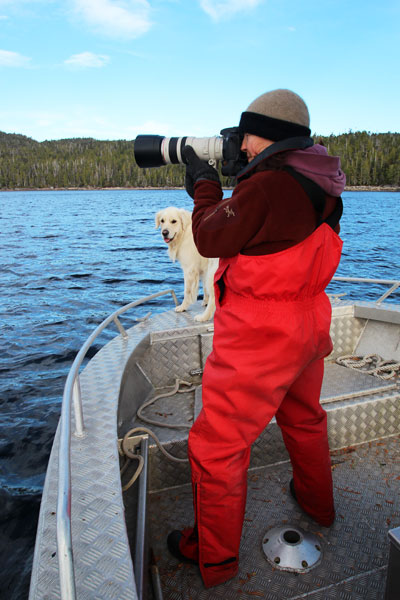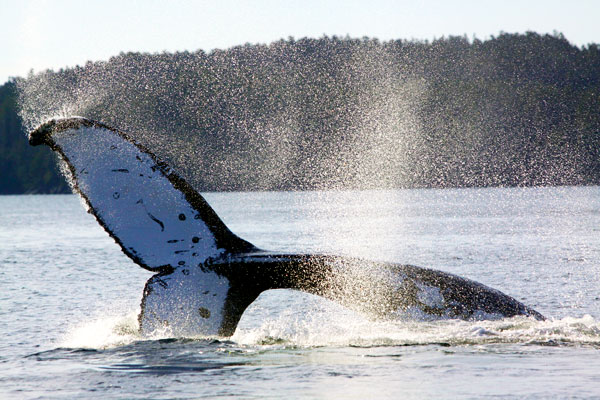Finding Yoda – Part 1
In 1996, citizen scientists Janie Wray and Hermann Meuter came together through their shared passion to protect and research whales on Canada’s Pacific Coast. Heading north to B.C.’s Great Bear region, they gained permission from the Gitga’at First Nations to build Cetacea Lab, a hydrophone research station on remote Gil Island. Since 2012, WWF has partnered with Cetacea Lab to support their work in monitoring and protecting whales. In the first of a 6-part blog series, Janie introduces us to Yoda, a charismatic humpback whale. ‘Finding Yoda’ follows the seasonal migration of humpbacks, showing how vitally important B.C.’s north coast waters are for humpback populations across the Pacific Basin.
Written by Janie Wray, Director of Cetacea Lab
- Cetacea Lab’s remote location on B.C.’s north coast, Hermann and I have witnessed the remarkable return of the humpback whale to Canadian waters over the last decade. Years of hunting had brought these gentle giants to the edge of extinction. In our first season at Whale Point, we counted only 42 whales in our area. Twelve years later, we’ve seen that grow to 318 humpbacks returning here each year.

Janie Wray and dog Cohen looking for Yoda in the coastal waters of the Great Bear Sea. © forwhales.org
We believe there are two important reasons for this increase of humpback populations in our area – access to plentiful food and quiet ocean waters ideal for whales to communicate in. The coastal cold ocean seas here are packed with nutrients and tiny forage fish that humpback whales consume, not with teeth, but through a baleen filter feeding system in their enormous mouths. And since allwhales are acoustic creatures, these quiet waters are an ideal haven for humpbacks that use sound to look for food, find mates, navigate and engage in social behaviours.
On the water and from the vantage point of our lab at Whale Point, Hermann and I noticed that we were seeing the same humpback individuals from year to year. We also began to realize that a large community of resident whales were returning to our area every season. The more time we spent with certain individuals, the more we recognized their particular personalities.
One September day, I was out in the research boat, a hydrophone suspended overboard to listen underwater to whales. Suddenly, I heard a huge explosion, then another. In the distance I could see massive amounts of water shooting up from the sea, but from what, I wasn’t sure. Traveling closer, I realized it was a humpback whale I’d never seen before, lifting a beautiful white tail high into the air, and slamming it down into the calm sea, displaying tail slap after tail slap. The whale we would come to know as Yoda then rolled onto its back, still managing to lift this massive tail up and out of the water and slam it back against the surface.

Yoda’s distinct white fluke markings and acrobatic behaviour. © Forwhales.org
I’d never seen a whale maneuver its tail in this manner. The pure strength and stamina it took to keep this going was truly amazing. One can speculate as to the real intention of this acrobatic display but that day it seemed this was Yoda’s announcement to the whale world – I have arrived!
Since this first arrival, Yoda has returned to Whale Channel every year within two or three days of the exact same day in late August every year – a remarkable feat given where this lively cetacean started from. Yoda and other humpbacks spend their winters in southern waters off Hawaii, Mexico or Japan. We don’t know yet where Yoda heads to when he leaves Caamano Sound in late November, but we do know that B.C.’s quiet north coast waters provide critical refuge for Yoda and other humpbacks during the summer and fall.
During the winter months, the pregnant females give birth to their calves, and males compete for the attention of females. They don’t eat during this entire period. Instead, in early spring, they head north to their feeding grounds in B.C. and Alaska, an amazing 3,000-plus mile migration across the Pacific Ocean.
Imagine that a mother, who has just given birth and is nursing a calf, now needs to swim 3000 miles to find food. Young juveniles and even last year’s calves, no longer with their mother, must make this incredible ocean journey north. In the spring, all humpbacks will leave the south in pursuit of food. It’s a journey that can take up to six weeks and often, when the whales first arrive, we notice the fat they’ve lost over the winter, especially the new mothers.
By the end of June, humpback blows–great heart-shaped puffs of vapour–are a constant sight from our window overlooking Taylor Bight. They’re accompanied by long feeding calls heard over our network of underwater microphones called hydrophones.

Whale dog Neekas watches as a humpback ‘flukes’ off the bow. © Linda Nowlan / WWF-Canada
At Cetacea Lab, Hermann and I, our summer interns, and even our dogs Neekas and Cohen follow the humpbacks’ return day and night. Through speakers mounted in our lab, sleeping quarters, kitchen and even the trees, we listen to the natural sounds of a quiet ocean. The grunts and chirps of fish are followed by long moments of complete silence, then an ancient and diverse sound fills the space – the haunting call of a humpback whale.


